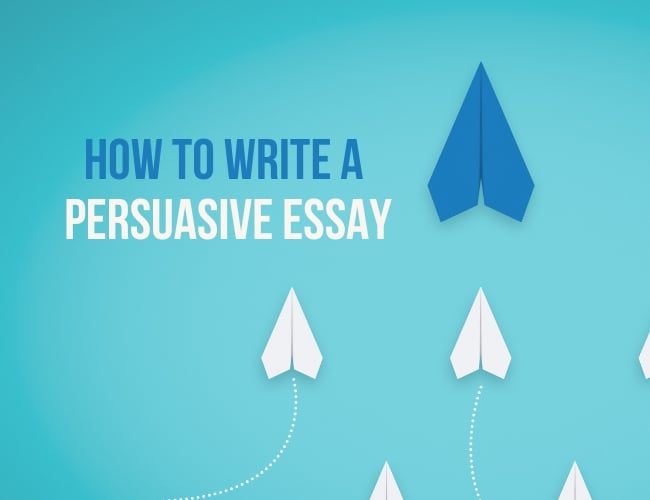So you've been assigned a persuasive paper and you're staring at a blinking cursor. What do you do first? How do you pick a good topic? Today we're going to learn how to write a persuasive essay, so you can get that assignment done.

As we continue our back-to-school series on writing essays, today we look at the persuasive essay.
Today's article is written by guest writer Cora Weems who is a senior at the University of South Carolina. She typically writes narrative poetry, slightly depressing short stories, and effective academic essays. Her hobbies include trying to get through a tall stack of unread books and handcrafts like card-making. Welcome, Cora!
What is a Persuasive Essay?
A persuasive essay is a piece of writing that aims to convince the reader to adopt a specific viewpoint or take action. To support it, you'll use logical arguments, compelling evidence, emotional appeals, and personalization.
In school, teachers often assign controversial issues, but you can develop your own topic too.
Learning to write a persuasive essay though is terrific practice for all kinds of writing. From public debate to sales letters and marketing, persuasive writing skills can carry you far beyond your school experience.
Let's go through the full process!
How to Write a Persuasive Essay: 6 Steps to Help You Start
Here are six steps to help you get your essay started.
Step 1: Pick a Suitable Topic
Maybe your teacher's already given you a prompt, or a specific topic to follow. Or maybe they've sent you on your way with just the rubric and an example paper to help you with formatting.
When it comes to persuasive writing, you need a position that you develop into a central idea. You'll have to support that position with all your evidence and reasoning.
Ideally, it should be a topic you're already familiar with and interested in. That will give you a better starting position and help keep you motivated to keep researching and writing!
When you are given a topic, you'll still want to develop a debatable position.
Here are three examples of broad persuasive essay topics:
- The Impact of Social Media on Society
- Climate Change and Environmental Responsibility
- The Role of Education in Reducing Income Inequality
It should not be a topic that has a specific single right answer or solution, but rather, a number of positions and solutions that you can take.
Your topic should be one of the very first things you address in your essay, in the topic sentence of your introductory paragraph, so your reader can immediately know what you're writing about.
To choose a suitable topic, ask yourself if the topic has multiple positions to take, and if you can reasonably research and take one position. That leads us to step 2:
Step 2: Research Both Sides, But Only Pick One
Even though you're only trying to advocate for one side of your argument, you should know the perspectives of both sides. Not only will this give you a better understanding of your topic, but it will help you prepare a counter argument that will make your essay more convincing.
If you've chosen a controversial topic, then there should be at least two opposing viewpoints that you can read about for supporting evidence.
Perhaps when you picked your topic, you already had a preferred stance, but researching the other side will give you fresh insight into what you actually believe, rather than relying on what you already knew.
Strong arguments typically address the opposing side's perspective and acknowledge them, for the purpose of refuting that argument and making your own appear stronger.
Or maybe you think both sides of your argument have valid points, so you think you'll about both and let the reader decide. Don't do that!
Not only is it more work for you, but the reader will be confused about your point.
You can acknowledge the strongest parts of the opposing view while you counter with your own perspective.
Step 3: Craft a Thesis Statement
Writing a thesis statement is a skill that goes beyond just persuasive writing. It's particularly important in this case because it gives both you and the reader a clear vision on how the rest of your paper is going to go.
You should explicitly state what you position is and what the rest of your paper is going to be about. It's usually a sentence or two long, so don't worry about being thorough or too specific. You'll Expand on it in your body paragraphs.
Typically, your thesis statement is located at the end of your introductory paragraph which allows for a natural transition from introducing your topic to the more specific reasons for your position on that topic.
You can use this statement to outline the rest of your paper, from what each paragraph is going to addressing the type of evidence you'll be using.
For example, if you choose the topic about the impact of social media on society, you want a thesis statement that covers the position and scope of your paper. Here's an example:
Social media like Facebook negatively impacts society through the ease of sharing misinformation, and both individuals and social media platforms need to do more to curb the spread of misinformation.
Notice how the position this writer takes is that Facebook negatively impacts society because of how it's used to share misinformation.
Now how would they support that thesis?
Step 4: Use the Right Evidence
Once you take a position, it's the time to show the reader why your viewpoint in particular is the one they should follow.
For academic writing, the most effective evidence is peer-reviewed articles published in academic journals. Peer-reviewed articles are seen as the most credible because they've been viewed and cleared by a number of different people, which means multiple people agreed that this article is reliable.
If you chose the wrong evidence, your entire argument is at risk of falling apart. You should not be choosing evidence that is false or unreliable, because your evidence is the foundation that your position stands upon.
Even if you don't want to go searching through databases for jargon-filled journal articles, all the evidence you choose should be from credible sources. It could be an expert opinion or some form of anecdotal evidence that could help personalize the issue for your reader.
You may have heard the terms “ethos,” “pathos,” and “logos” in class. When crafting something persuasive, you should appeal to authority, emotion, and logic.
Using evidence from an expert is an appeal to ethos or authority, credibility.
If you cite statistics from a reputable source, that might be an appeal to logic.
A related anecdote that makes the reader angry or sympathetic may be an emotional appeal.
The best persuasive essays use all three.
A persuasive argument is typically supported by a number of different sources that appeal to all parts of the reader, from their logical side to their more heartfelt one. All of those different perspectives will come together to make your argument stronger and more effective.
For example, in our example above on the impact of social media, the thesis statement reads: “Social media like Facebook negatively impacts society through the ease of sharing misinformation, and both individuals and social media platforms need to do more to curb the spread of misinformation.”
To support, this paper would need to show data about misinformation on Facebook, demonstrate the ways that misinformation negatively impacts society, and then offer the best solutions in the form of individual and company interventions.
Step 5: Use Natural Transitions
As you add evidence to your argument, use transitions that help the reader see the connections you're making.
If you've ever felt your eyes begin to glaze over when you see a wall of text or a bunch of graphs and statistics in one place, the writer lost you in making the needed connections and transitions. You don't want to do that to your reader.
Introduce a point, then use evidence to support that point, and then expand on that evidence. Whether it's by paraphrasing it so the reader can more easily digest it, or by showing the reader exactly how it connects back to what you're trying to persuade them.
This not only applies to evidence, but also moving between paragraphs. There should be a topic sentence near the beginning of every paragraph to tell the reader what that paragraph is about, and you should use the last sentence of the previous paragraph to lead into it.
Doing this helps improve the flow of your essay and keeps the reader's attention. If they never have to stop and wonder how you got to a certain point, then you can keep all their attention purely on your argument.
Step 6: Make It Applicable
As you bring your essay to a close, most persuasive papers end with some call to action. It might be that you are asking the reader to understand an issue differently. Maybe you want to them to change their minds or donate money or take other action.
Make sure your conclusion answers the question, “So what?” Give your reader something to occupy their mind even after they're done reading. You want to tell them why reading your argument was important, and give them a reason to keep thinking about your argument even after you're done.
Doing so will leave a lasting impression of your paper on your reader, which will make your essay more persuasive and effective.
Persuade us!
So there you have it. Some ways to help move that blinking cursor.
It's okay to start with a draft that's just you cramming all your ideas onto a document. Don't worry about formal language yet. Reorganizing and rewriting that rough draft is part of what makes a good paper.
Plus, writing it all out will let you see what you actually thought the most important parts were, and revision allows you to highlight those strong points and focus on what you think the reader should know.
Here's a question to help you keep going even after you've finished the messy first draft: What makes this essay important to you?
Beyond the grade it will get in class, beyond how it will affect your GPA or academic standing, what about this essay is important? What about this will affect more people than just you?
Throughout your life, you'll constantly find times where you have to use persuasion. Maybe it won't be in essay format or presented in a Power Point, but finding ways to be persuasive is something that will help you in the rest of your life.
So let's think of this essay as practice, and learn how to be as persuasive as we can.
What are your best tips for persuasive writing? Share in the comments.
PRACTICE
Set your timer for fifteen minutes. Choose a persuasive topic that you can take a clear position on. Make a list of the reasons for your current view point. Then, do some research and read possible evidence both in support and in opposition to your view. Choose the strongest two to three pieces.
If you still have time, craft a thesis statement that distills your argument, and begin writing the essay. While it will take you longer than fifteen minutes to write the essay, sometimes just getting started in fifteen minutes is enough to make a difference!
When finished, post your thesis and current direction in the Pro Practice Workshop, and leave feedback for a few other writers.
This article is by a guest blogger. Would you like to write for The Write Practice? Check out our guest post guidelines.



0 Comments